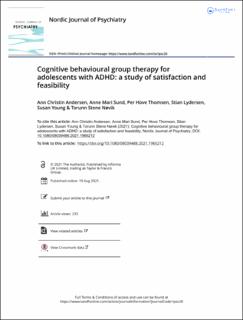| dc.contributor.author | Andersen, Ann Christin | |
| dc.contributor.author | Sund, Anne Mari | |
| dc.contributor.author | Thomsen, Per Hove | |
| dc.contributor.author | Lydersen, Stian | |
| dc.contributor.author | Young, Susan | |
| dc.contributor.author | Nøvik, Torunn Stene | |
| dc.date.accessioned | 2021-09-10T05:29:08Z | |
| dc.date.available | 2021-09-10T05:29:08Z | |
| dc.date.created | 2021-09-08T15:43:19Z | |
| dc.date.issued | 2021 | |
| dc.identifier.issn | 0803-9488 | |
| dc.identifier.uri | https://hdl.handle.net/11250/2775031 | |
| dc.description.abstract | Adolescents with ADHD are at increased risk of adverse outcomes and a negative life trajectory into adulthood. Evidence regarding treatment specifically tailored for the needs of this age group are still limited. High dropout rates, discontinuation of medication and treatment resistance are common issues in this population, and the patient perspective on new treatment options is therefore important. In this study, we aimed to investigate treatment satisfaction and feasibility of a group CBT program for adolescents with ADHD. We further aimed to identify any baseline characteristics predicting satisfaction. Materials and methods This study was part of a larger RCT of group CBT as add-on treatment for adolescents aged 14–18 years (Mean age 15.9 years, SD 1.3) with ADHD in Norway. Satisfaction and feasibility in the treatment group (n = 48) were measured by completion of an evaluation questionnaire, attendance of group sessions and a group-leaders checklist. Predictors of satisfaction were analysed using linear regression. Results Overall satisfaction was very high with a significant age effect, the eldest participants being most satisfied. Attendance rate was high with few dropouts and medical adherence during the treatment period was good. Group-leaders generally self-evaluated adherence to treatment manual positively but addressing resistance towards homework as challenging. Conclusions The participants were very satisfied with the group CBT treatment. Treatment options that are accepted and well-liked by the targeted population have the potential of reducing resistance towards treatment, improving future health and adherence to medication. The program is considered suitable for a clinical setting and may represent a feasible treatment supplement for adolescent ADHD. | en_US |
| dc.language.iso | eng | en_US |
| dc.publisher | Taylor & Francis | en_US |
| dc.rights | Attribution-NonCommercial-NoDerivatives 4.0 Internasjonal | * |
| dc.rights.uri | http://creativecommons.org/licenses/by-nc-nd/4.0/deed.no | * |
| dc.title | Cognitive behavioural group therapy for adolescents with ADHD: a study of satisfaction and feasibility | en_US |
| dc.type | Peer reviewed | en_US |
| dc.type | Journal article | en_US |
| dc.description.version | publishedVersion | en_US |
| dc.source.journal | Nordic Journal of Psychiatry | en_US |
| dc.identifier.doi | 10.1080/08039488.2021.1965212 | |
| dc.identifier.cristin | 1932550 | |
| cristin.ispublished | true | |
| cristin.fulltext | original | |
| cristin.qualitycode | 1 | |

